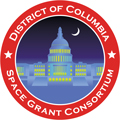NASA Mission Directorates
All DCSGC-funded projects are required to align with one or more NASA Misson Directorates. Please review the information below to find out more about the Mission Directorates before choosing which Mission(s) and research priority area(s) your project most closely aligns with. For examples of research questions and projects within each Mission Directorate, visit the websites linked below.
Aeronautics Research Mission Directorate (ARMD)
NASA’s aeronautics programs focus on six areas of research that develop solutions to the major challenges and opportunities for aviation: a growing demand for mobility, the sustainability of energy, the sustainability of the environment, and technology advances in information, communications and automation. ARMD conducts high-quality, cutting-edge research that generates innovative concepts, tools, and technologies to enable revolutionary advances in our Nation’s future aircraft, as well as in the airspace in which they will fly. ARMD programs will facilitate a safer, more environmentally friendly, and more efficient national air transportation system.
Exploration Systems Development Mission Directorate (ESDMD)
The Exploration Systems Development Mission Directorate defines and manages systems development for programs critical to the NASA’s Artemis program and planning for NASA’s Moon to Mars exploration approach in an integrated manner. ESDMD manages the human exploration system development for lunar orbital, lunar surface, and Mars exploration. ESDMD leads the human aspects of the Artemis activities as well as the integration of science into the human system elements. ESDMD is responsible for development of the lunar and Mars architectures. Programs in the mission directorate include Orion, Space Launch System, Exploration Ground Systems, Gateway, Human Landing System, and Extravehicular Activity (xEVA) and Human Surface Mobility.
Space Operations Mission Directorate (SOMD)
SOMD manages NASA’s current and future space operations in and beyond low-Earth orbit (LEO), including commercial launch services to the International Space Station. SOMD operates and maintains exploration systems, develops and operates space transportation systems, and performs broad scientific research on orbit. In addition, SOMD is responsible for managing the space transportation services for NASA and NASA-sponsored payloads that require orbital launch, and the agency's space communications and navigation services supporting all NASA’s space systems currently in orbit.
Science Mission Directorate (SMD)
The Science Mission Directorate (SMD) is responsible for directing and overseeing the nation’s space research program in Earth and space science. The Directorate engages the external and internal science community to define and prioritize science questions and seeks to expand the frontiers of five broad scientific pursuits: Earth Science, Planetary Science, Biological and Physical Sciences, Heliophysics, and Astrophysics.
Space Technology Mission Directorate (STMD)
NASA’s Space Technology Mission Directorate (STMD) aims to transform future missions while ensuring American leadership in aerospace. As NASA embarks on the next era of space exploration with Artemis, STMD is advancing technologies and testing new capabilities at the Moon. Many of the same systems will prove critical at Mars. STMD’s portfolio spans a range of discipline areas and technology readiness levels. STMD bolsters and funds diverse ideas from entrepreneurs, researchers, and innovators across the country. Space technology research and development occurs at NASA centers, universities, national labs, and small businesses. STMD leverages partnerships with other government agencies and commercial partners to quickly advance and demonstrate cross-cutting capabilities.





